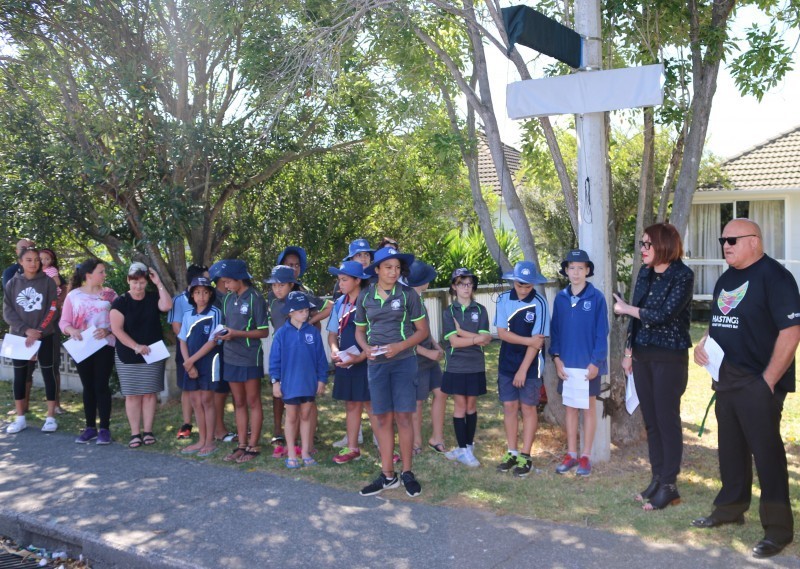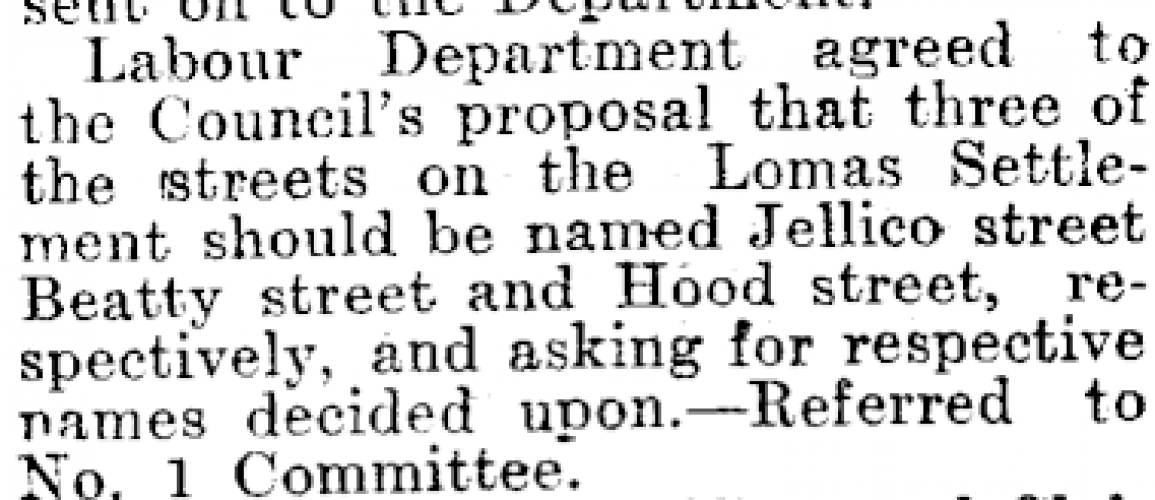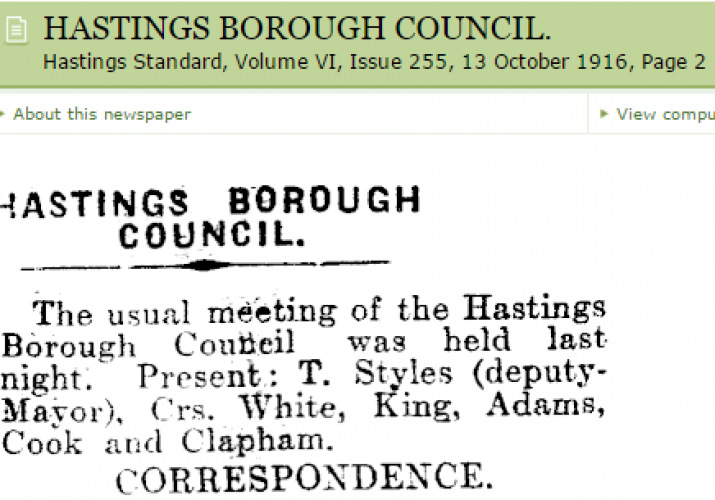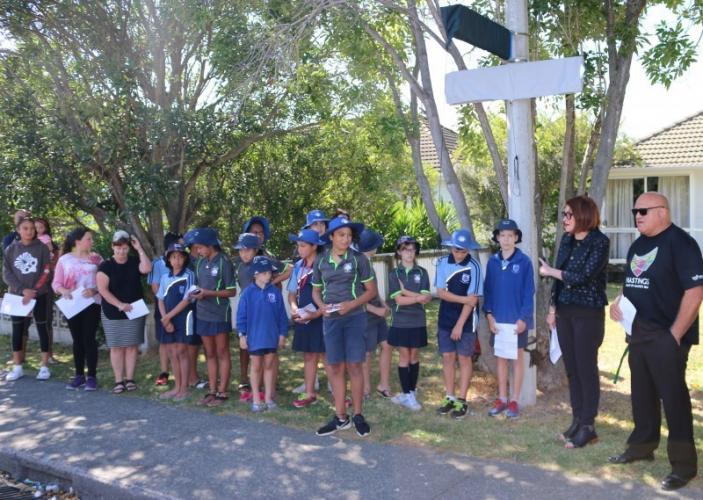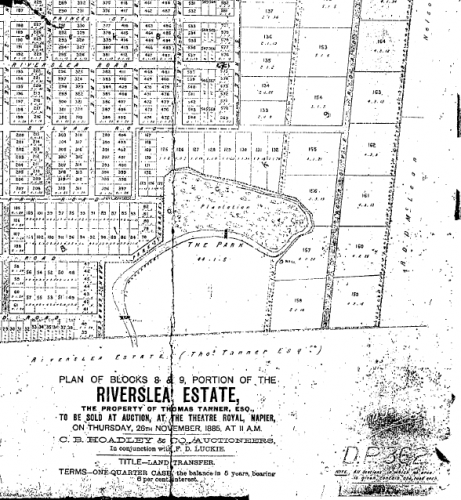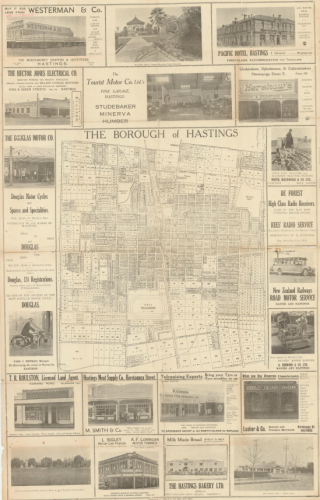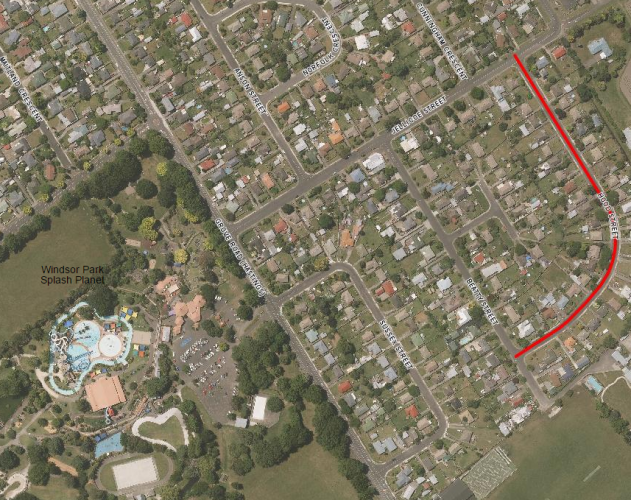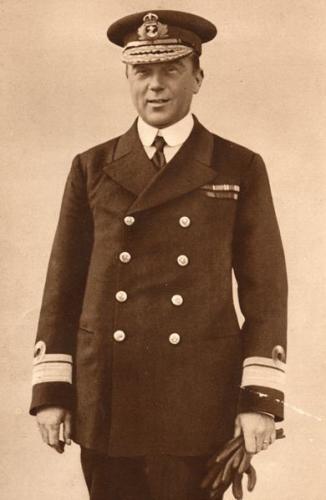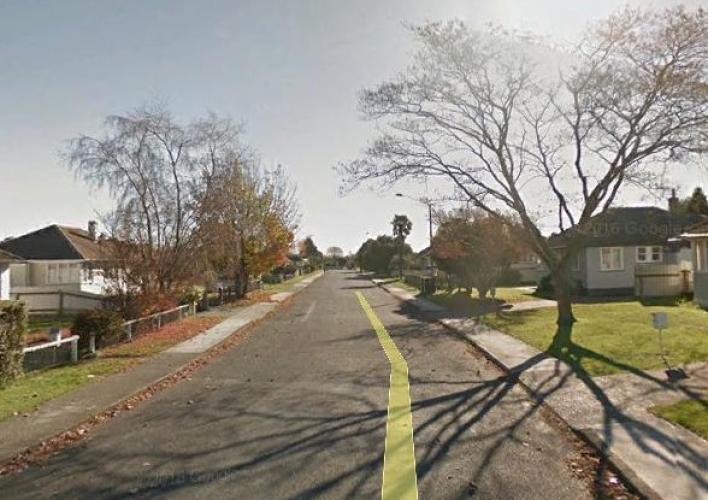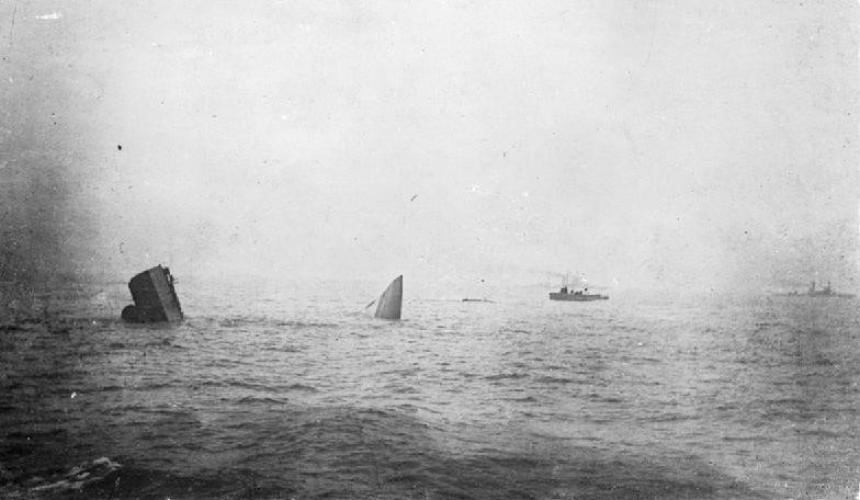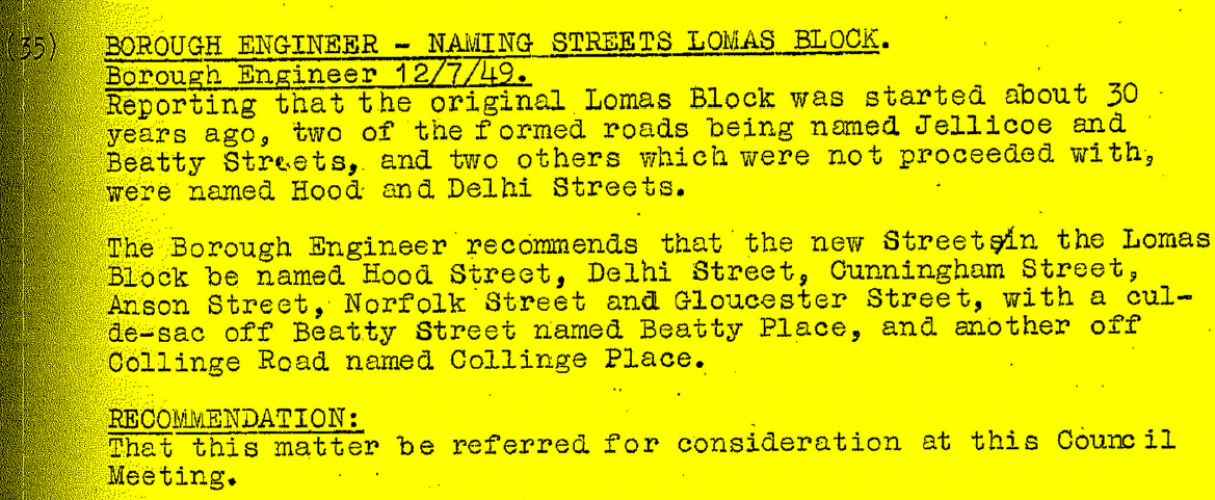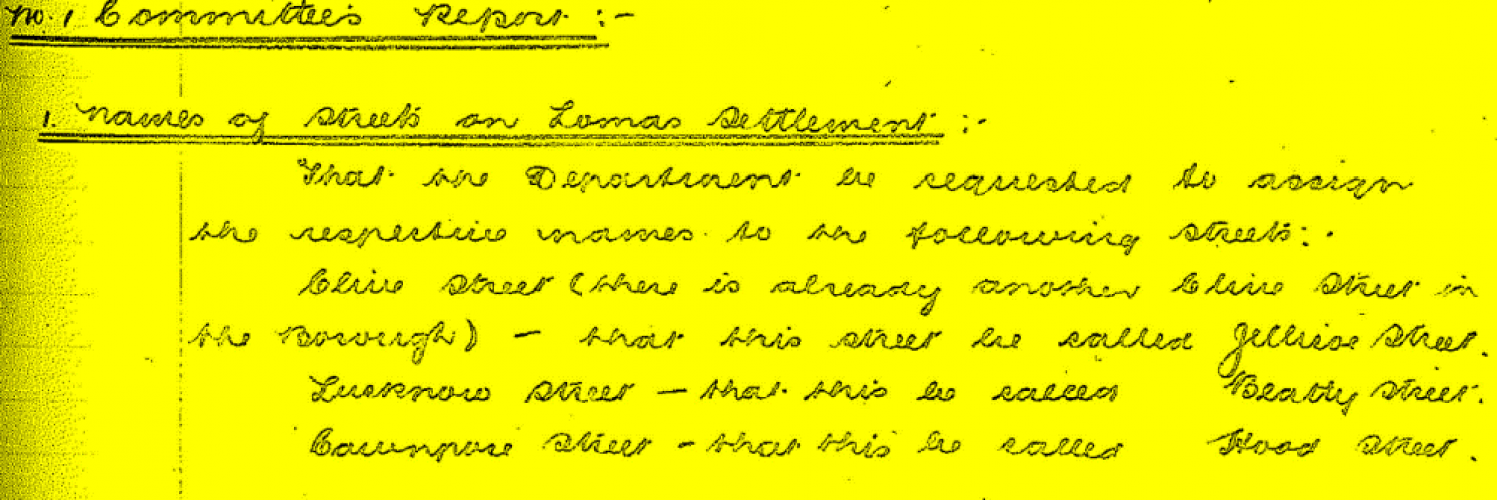060 Hood St Hastings, street scene 2017
Reason for the name
Hood Street was named after Rear-Admiral Sir Horace Hood, who was one of the three key leaders in the Battle of Jutland, alongside Admiral Jellicoe and Admiral Beatty. Admiral Hood died when the HMS Invincible sank, alongside approximately 1,000 of his shipmates (and others on other ships that sank) in the Battle of Jutland in WWI.
Hood Street is part of what was once called the Lomas subdivision in the Mayfair suburb of Hastings, near Windsor Park and local attraction Splash Planet. The streets in this area were all named for naval reasons, after Admirals or battleships (Jellicoe, Beatty, Hood, Cunningham, Sussex, Norfolk and Anson). Hastings Borough Council had a policy in the early 1900s of naming new streets after English generals or admirals. A decision was made to name three streets in the “Lomas subdivision” after Admirals who had fought in the Battle of Jutland, which was a significant naval battle in WWI.
Authors: Cherie Flintoff, Helen Gelletly Hastings District Council, Madelon van Zijll de Jong, Katrina Barrett
Of interest, a battleship HMS Hood was built starting in 1916 but not complete and commissioned until 1920, and fought in WWII alongside other ships in Force H. She was launched on 22 August 1918 by the widow of Rear Admiral Sir Horace Hood.
This ship was built after the decision to name these streets was initially made, and this highlights the importance of the name, which stemmed down from Admiral Samuel Hood, the great, great grandfather of Sir Horace Hood. Admiral Horace Hood showed his promise early, setting a record of 4,398 out of a possible 4,600 marks in the examinations for the rank of Lieutenant.
HMS Invincible was the flagship of Rear-Admiral The Honourable Horace Lambert Alexander Hood, and served in the 3rd Battlecruiser Squadron in the Battle of Jutland.
HMS Invincible was built in 1907 and was the first of the battle cruisers built, leading the dreadnought revolution. By the time she was sunk, she was the slowest and oldest of the battlecruisers in the battle.
The HMS New Zealand, which New Zealanders funded the cost to build, was also in the Battle of Jutland, in the 2nd Battlecruiser Squadron. The officer in charge of ‘X’ turret on the HMS New Zealand was Lieutenant A.D. David Boyle, the only known New Zealander to have served at all three major naval battles of World War One.
In May 1916, having intercepted and decoded German messages, 51 ships of the Grand Fleet were at sea to intercept the German High Seas fleet. The Grand Fleet was commanded by a future New Zealand Governor-General, Admiral Sir John Jellicoe, and the fleet included 28 dreadnought battleships and nine battlecruisers.
On 30 May, the entire Grand Fleet, along with Admiral Beatty's battlecruisers were ordered to sea, to intercept the German High Seas Fleet. To support Beatty, Admiral Hood took his three battlecruisers ahead of the Grand Fleet.
Hood attempted to intercept two fleeing ships, but returned to the main fleet when he received the message that Beatty was engaging five battlecruisers. On the way, Hood’s ships engaged four German cruisers that had been firing on the light cruiser HMS Chester. They engaged, scoring hits on the Wiesbaden and the Pillau. The German ships turned for the south at 6:00 and attempted to find shelter in the mist. The British ships were attacked in turn by the light cruiser Regensburg and 31 destroyers of the 2nd and 9th Flotillas and the 12th Half-Flotilla, which were driven off by Hood's remaining light cruiser Canterbury and the five destroyers of his escort.
At 6:21, with both Beatty and the Grand Fleet converging on him, Hood turned south to lead Beatty's battlecruisers in engaging Hipper's battlecruisers, which were 9,000 yards (8.2 km) away. While some clear hits on Hipper's flagship Lützow by the Invincible eventually sealed the Lutzow’s fate, at 6:30 Invincible abruptly appeared as a clear target before Lützow and Derfflinger and the two German ships then fired three salvoes each at Invincible and sank her in 90 seconds, blowing the ship in half, including a direct hit on Q turret. Of her complement, 1026 officers and men were killed, including Rear-Admiral Hood. There were only six survivors picked up by HMS Badger. The names of the survivors were: Commander Hubert E. Dannreuther, RN, Lieutenant Cecil. S. Sandford, RN, Chief Petty Officer P. T. I. Thompson, Yeoman of Signals Walter Maclean Pratt, Able Seaman Ernest George Dandridge, Gunner Bryan Gasson, RMA.
All except Gunner Gasson were stationed in the fire control top located at the top of the tripod foremast. Gasson was stationed in 'Q' turret itself. When the magazine exploded he was somehow thrown clear of the ship.
The Hon. H. L. A. Hood was the youngest Admiral in the British Navy. After the battle Beatty said of Hood, "You should have seen him bring his squadron into action, it would have done your heart good, and no one could have died a more glorious death. Many ships and sailors were lost that day, as Admiral Jellicoe’s despatch noted:
I deeply regret to report the loss of H.M. ships ‘Queen Mary,’ ‘Indefatigable’ (below – Maritime Quest), ‘Invincible,’ ‘Defence,’ ‘Black Prince,’ ‘Warrior,’ and of H.M. T.B.D.’s ‘Tipperary,’ ‘Ardent,’ ‘Fortune,’ ‘Shark,’ ‘Sparrowhawk,’ ‘Nestor,’ ‘Nomad,’ and ‘Turbulent,’ and still more do I regret the resultant heavy loss of life. The death of such gallant and distinguished officers as Rear-Admiral Sir Robert Arbuthnot, Bart., Rear-Admiral The Hon. Horace Hood, Captain Charles F. Sowerby, Captain Cecil I. Prowse, Captain Arthur L. Cay, Captain Thomas P. Bonham, Captain Charles J. Wintour, and Captain Stanley V. Ellis, and those who perished with them, is a serious loss to the Navy and to the country. They led officers and men who were equally gallant, and whose death is mourned by their comrades in the Grand Fleet.
New Zealand also felt the loss of those in the Royal Navy defending the Empire. An article from the Timaru Herald in June 1916 discusses the South Canterbury response to raising funds through voluntary subscription for the families of the sailors lost in the Battle of Jutland. They believed New Zealand ought to be able to raise £250,000, seeing it as “a duty and a privilege to contribute generously to the needy survivors of those who had given their lives for us.”
While many of the New Zealanders in the Battle of Jutland were on the New Zealand, which came through relatively unscathed, others were based on ships that did not fare so well. Stoker First Class Leslie Raymond Follett is one of many New Zealanders who died as a result of First World War service, when he went down with the Queen Mary. He is listed on the Royal Navy’s Roll of Honour. Reuben Carpendale went down with the HMS Black Prince. Cyril Padley fared better on the destroyer Moresby, living through the battle.
Admiral Hood was posthumously knighted in the Order of the Bath. He had previously been made a Member of the Royal Victorian Order.
While the German navy claimed some victory in the Battle of Jutland, due to the damage they inflicted, it inflicted a heavy toll on an already weakened German navy, which it never really recovered from.
The naming of Hood Street was first proposed and accepted in 1916, with Beatty and Jellicoe. It was even shown in a 1925 map, although it wasn’t actually formed until the 1950s.


